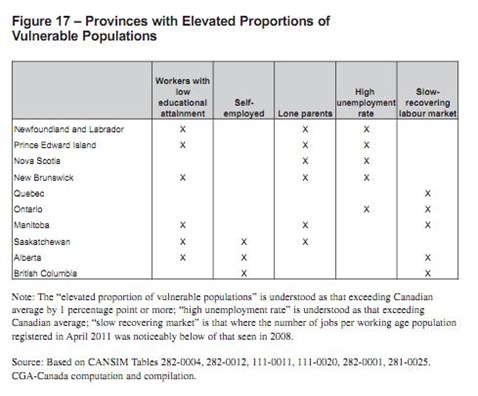Canadian household debt is at at record levels according to report by the Certified General Accountants Association.
The latest report adds a new twist to a discussion of the potential risks for consumer debt in this province discussed in a post last week.
Table 17 from the report shows provinces with segments of the population considered to be highly vulnerable for debt growth and financial problems associated with heavy debt loads.
Another table (19 on page 74) shows levels of savings for Newfoundland and Labrador are relatively low. At the same time, house prices increased at the highest average level of all provinces for the period 2007 to 2009.
According to some thinking, the economic vulnerability represented by small savings could be offset by the relatively high level of equity that could be represented in the high house prices. That would theoretically make Newfoundland and Labrador no more risky than Alberta where the savings levels are the highest in the country while house prices have dropped lately.
Small problem.
House prices can shift dramatically while savings and investments tend to hold value over a long period of time.
The summary of that chapter’s conclusions also sounds a strong warning, even allowing that the conclusions are for the country as a whole, not just one province. Incidentally, this is all one paragraph in the report. The layout is changed here to make reading easier:
First, the positive signs of improving labour market conditions portrayed by the unemployment rate and the hiring intentions of firms may be deceptive. Labour market conditions continue to be fairly weak: the market’s ability to keep up with the increase in working age population recovers slowly (and even deteriorates in some of the provinces); the long-term unemployment rate continues to increase while the decline in the proportion of discouraged workers has not yet materialized. Weak labour market conditions may suppress the short-to-medium term growth in earnings while increased and more prolonged absence of employment may decrease individual’s life-long earnings.
Second, certain socio-economic groups (i.e. youth, workers with low educational attainment, lone parents, and self-employed) may be seen as vulnerable as they are faced with higher labour market stress due to elevated likelihood of longer-term unemployment and reduced employment options.
Third, individuals in vulnerable groups that reside in provinces having a weak labour market may be at a higher risk of elevated financial stress.
Fourth, the recent recession and economic recovery brought only slight improvements to the conventional savings out of income; at the same time, accumulation of savings through wealth has been weakening in the past several years. Neither active savings from income, nor passive savings through equity are evenly distributed across provinces and households. The lack (or low levels) of active savings may jeopardize individual’s ability to pay and honour debt obligations in the future.
- srbp -
